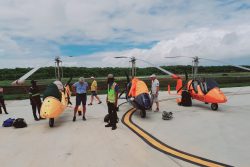YASUNI PARK, Ecuador (Reuters) – The manager of state oil company Petroamazonas defended Ecuador’s plans to expand exploitation of major oil reserves in one of the world’s most species-diverse rainforests, saying it will ensure minimum environmental impact and use appropriate technology.
The OPEC country is avidly seeking resources to revitalize an ailing economy, after a fall in oil prices and a major earthquake.
Ecuador expects to raise revenues of about $2.4 billion annually as of 2022 when it completes the development of the Ishpingo, Tambococha, and Tiputini (ITT) fields and Block 31, located in the Yasuni National Park, a 9,820-square-kilometer (6,100-square-mile) swathe of rainforest on the equator.
“This is the second phase of oil exploration in Ecuador … that allows for cheap and economically profitable exploitation,” said state oil company manager Alex Galarraga.
“There is the technology to greatly minimize the environmental impact, to live in harmony with nature, and to maintain the most critical parts of the park with exhaustive care,” he told Reuters during a tour of the heart of the park on Friday.
He cited smaller platforms, clustered wells, re-use of gas and water, as well as eco-friendly pathways to the oil installations.
Yasuni National Park has long been pivotal in global environmental debates.
Challenging the world to save Yasuni a decade ago, former president Rafael Correa asked wealthy countries to donate $3.6 billion to offset revenue lost by not drilling there.
The initiative brought in less than 4 per cent of that amount so Correa scrapped the plan six years later and authorized drilling, saying the world had failed Ecuador.
Environmental and indigenous movements have asked authorities to suspend the work.
Between ITT and Block 31, reserves total more than 2 billion barrels of crude and require an investment of almost $6 billion.
Petroamazonas plans to install some 26 platforms to drill 651 wells in the ITT block.
OPEC’s smallest partner currently produces some 530,000 barrels per day and expects to reach 700,000 by 2022.









